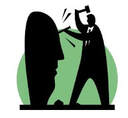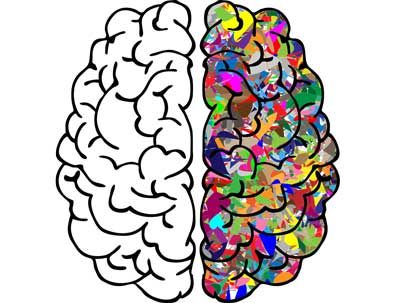 A sculptor is working in his studio, completing a large scale piece of public art. He gets so lost in the process that he forgets the 5:00 p.m. deadline to enter this work in a national juried competition.  An abstract painter is at home at her desk, checking off items on her family’s to-do-list: make a dentist appointment for her son, pick up the dry cleaning, balance the checkbook. She wonders why she has no energy to go into her studio and paint.  A fashion designer is sketching in her notebook, pleased at the look of the new dress she has created. She can envision her model walking down the runway at New York Fashion Week. But when the designer sits down at her sewing machine, she has difficulty following the detailed instructions about how to get a zipper to lie flat on the delicate fabric. What is going on here? Why does the sculptor forget his most important goal? Why does the painter get stuck in routine tasks, when all she really cares about is making art? Why is it easy for the fashion designer to imagine her creation walking down the runway, but difficult for her to execute the details of the design? Are any of these dilemmas familiar to you? Do you recognize your own struggles as an artist?
If you do, you may realize that the source of these dilemmas is not “out there” in the challenging demands of the art world, but right inside your brain. Think about your own experience as an artist. When making art you are using right brain skills and processes. You are visual, intuitive, spontaneous, and you may stay in that mode for hours or even days at a time. You experience the world in a holistic way; your imagination runs freely as you make something new. This is how the creative process works while you are making art. But when you are working on your career, suddenly all of the demands are for a different kind of thinking. You must pay attention to deadlines, follow detailed instructions for entering your work in exhibitions, develop and follow a business plan to get where you want to go. You have to become skilled at talking about your work to collectors and the public. You need to write about your work so that others can understand it. Unfortunately, all of these critical career skills are housed in the left side of your brain. Do not despair. My work with artists has revealed a simple and elegant answer to this dilemma. When you translate left brain concepts into visual images or spatial objects, your right brain understands what they mean. You are then able to see how such ideas apply to your own career. You are able to use your strengths as an artist to learn skills that seem foreign to you. In my next blog post I will show you how this process works! Mary Mary Edwards, Ph.D Career & Life Coach for Artists “Left Brain Skills for Right Brained People” Instagram: coachingforartists.maryedwards Comments are closed.
|
Mary's BlogAs an artist coach, I bring a unique combination of business knowledge, art world experience, and professional coaching skill to my practice. |
